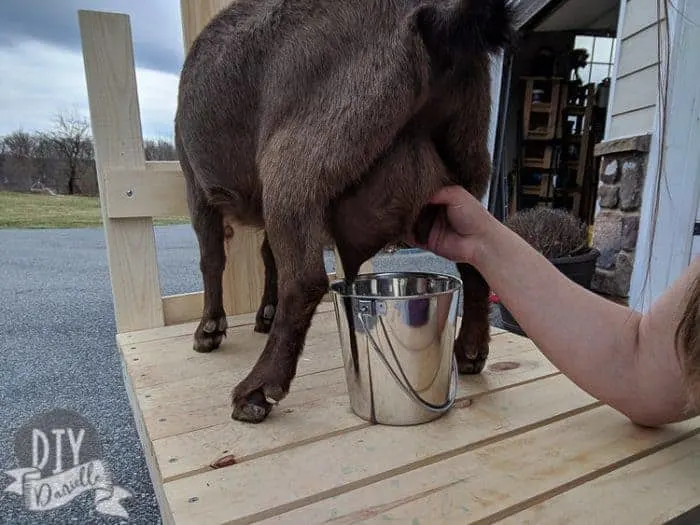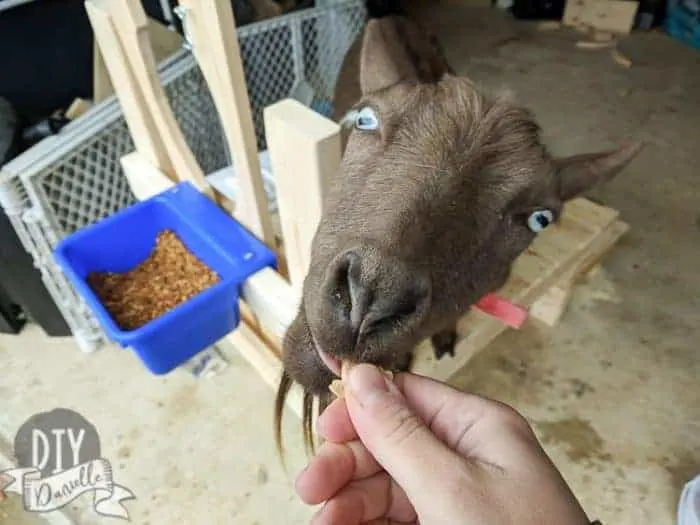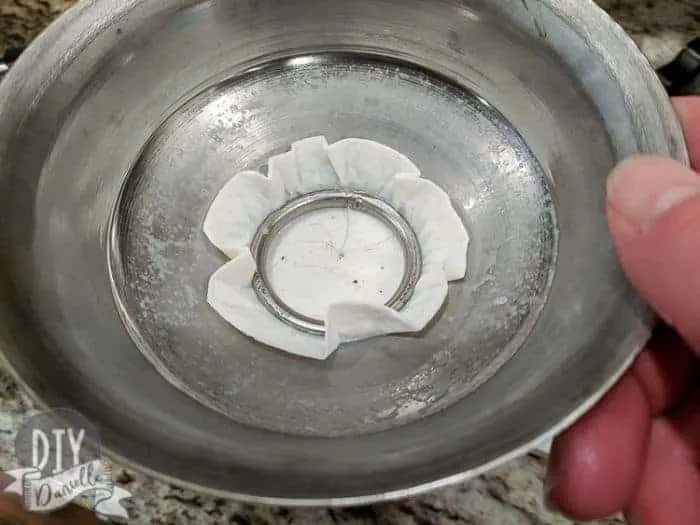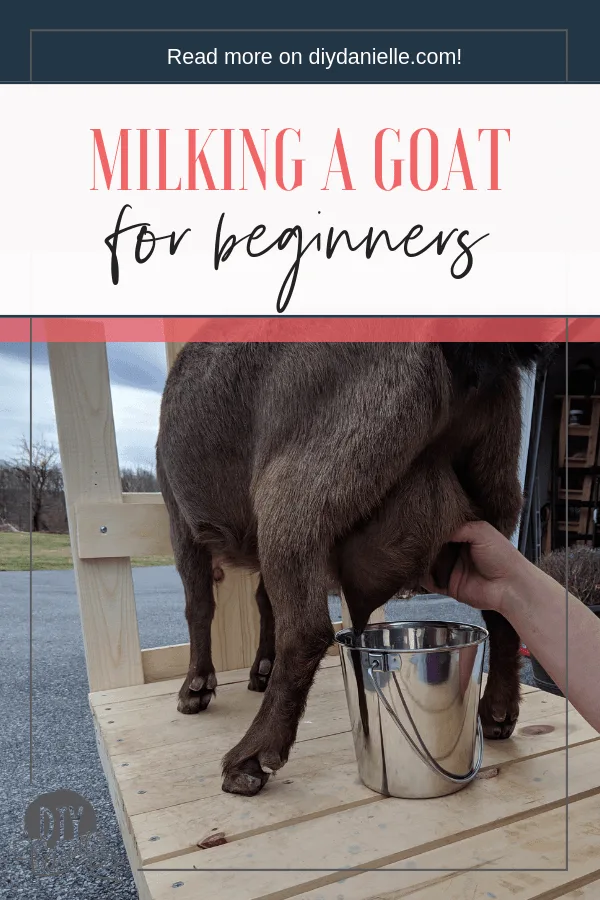
Learn how to milk a goat, particularly small breeds like Nigerian Dwarf goats. This beginner’s guide to milking discusses everything you need to know.
This post contains affiliate links. If you use these links to make a product purchase, I may receive a commission. This does not impact your price for the product.
We brought home our first goats in February. Cleo/Ivy is our doe in milk. We also bought a wether, Timmy, and a doeling, Juniper. Goats are herd animals and need friends to be happy. I would love to have two or three milk goats eventually.
For now, I’ve been learning how to milk our goat and it’s been so interesting! I wanted to share with you what I’ve learned along the way. While I’m certainly a beginner, I hope my perspective as someone new to milking will be helpful to others who are interested in owning milk goats.
Goat Milking Supplies
- Animal crackers
- Milking stand
- Milking kit for your size goat. I bought the “Basic Milking Kit for 1-2 goats” from the Caprine Supply website, making sure to choose the set for the small breed goats. They’re way cheaper than Amazon. It included:
- 1 small stainless steel strainer
- 200 3-5/8″ filters for your strainer
- 2 qt. stainless steel milk pail
- Fight Bac teat spray
- Aluminum strip cup with screen
- Empty bucket, soap, water, and a clean cloth
- Wet bag or laundry bin to store dirty cloths
- Optional: Milking Machine
- Simple Pulse seems to be the brand that many recommend.
Breeds of Milk Goats
I choose Nigerian Dwarf goats because they’re small. That said, they aren’t the fastest at eating brush, and they aren’t a breed that produces a ton of milk. My doe produces around 1 lb 3 oz to 1 lb 12 oz per milking.
Saanen goats are one of the highest producers of milk and they’re a breed that I’d love to add to my herd eventually. My friend Marie, from JustPlainMarie, says she LOVED her Saanen goats and found them extremely gentle and friendly.
Any goat will produce milk but the breeds known for their milk production include: Alpine, Lamancha, Nigerian Dwarf, Nubian, and Toggenburg.
A few people mentioned Nubians were screamers so they were a no go for me, haha.
Here’s a good list of the milk production comparing different breeds of dairy goats.
Feed Impacts Milk Production
We feed alfalfa hay which is pretty pricey, as well as unlimited grain while on the milking stand. I’ve seen where the feed impacts my doe’s milk production. On days where I’ve fed more 2nd cutting orchard hay or left her out in the field to forage, she produces less milk.
Better quality feed will impact your doe’s production.
How Long Does it Take to Milk a Goat?
So this was one of the first questions that I had when I got a milk goat. Initially, it took me a lot longer to milk my goat, simply because I needed to rest more and couldn’t quite get the technique down. My doe and I were also just getting the hang of things and she was sitting in my milking pail a lot…
Once we worked all of those kinks out, I found that I can get all of my things together, get her, milk her, and be back in the house in about 15 minutes.
This equates to 30 minutes a day of milking. I’d like to move our milking area closer to her shed in order to cut the time down. She’s a bit slow to go from point a to point b.
This does not mean that owning goats is a 30 min a day commitment. You still need to do goat chores which vary depending on your setup.
Beginner’s Tips for Milking a Goat
I’m certainly a beginner, but here are the things that I feel are most important to know about learning to milk a goat.
Feed Grain on the Stand
We feed our doe exclusively on the milking stand. This is her time to eat. We do not feed our doeling or wether grain at all… my understanding is that there’s no need for it and there’s the potential risk of it causing health issues for our wether. So the grain never makes it out to their pen.
Giving grain on the stand, as well as other treats, makes this a special time for the doe and gives her something to distract her while you milk. This is extremely helpful. I let my doe eat as much as she wants… and I’ll refill the feeding area if she finishes it all (unusual).

You’ll be sore.
You have muscles in your hands that will be sore: rub them after each milking or you’ll start to cramp up. I find that milking aggravates my carpal tunnel.
Can I just use a machine?
While milking machines are an option, they’re expensive and seem to require so much cleaning that, for a someone with one or two goats, cleaning the machine after each use is probably more time consuming than just milking the goat.
It’s not like the movies.
You DO NOT PULL DOWN when you milk a goat. You squeeze and release. Your top three fingers hold the teat and your bottom two fingers are squeezing.
Do I need a milking stand?
I can’t imagine what I’d do without one. The milking stand, once properly, setup, helps keep my doe in place so I don’t need to worry about her jumping around as much. It doesn’t hurt her. It’s more comfortable for my back. I attempted to milk on the ground a few times and it’s pretty difficult.
Let Down.
You can feel the milk ‘let down’ (flow) into the teat. This is your cue to squeeze the teat. But initially you may need to trigger the release with a few squeezes.
Know when you’re done.
The doe’s bag will feel empty when you’re done. While you can massage to get a second letdown, you are really at the end of your time milking once it starts to feel empty. The bag even looks different.
Swap hands.
I find that sometimes swapping hands helps to get additional milk out. Ie. Milking the left teat with my right hand. I anticipate this is just allowing milk to come from other ducts, similar to swapping your baby’s position when breastfeeding. Or maybe it’s all in my head. Something.
The only reason I discovered this is because my right hand is stronger than my left and I was giving my left hand a break when I first started. This was more useful when I first started than it is now that I have a routine and can milk fairly quickly/effectively.
There’s a point of diminishing returns.
While I can definitely get more milk if I keep working at it, often it’s best to stop while I am ahead. There’s a point where it becomes more work to get milk out than it’s worth.
There’s a learning curve.
It took me three or four days before I stopped wanting to cry because I “wasn’t getting this milking thing.” It was a week before I felt like I had a decent idea what I was doing It was two weeks before my hands stopped being so sore. It was three or four weeks before it really became just a comfortable part of my routine.
Be friends with your doe.
Get to know her. Give her rubs on the milking stand and feed her treats. You want to treat her right because if she doesn’t kick you in the face for messing up milking royally those first few days while you’re learning, she’s a complete sweetheart. I like to stop midway and give an animal cracker to my doe.

Be prepared for some shenanigans.
While I udderly adore my doe now, my attitude toward her wasn’t quite so nice when she was irritated with my initial lame attempts at milking that first week. She tried stepping in my bucket, SAT her udder right in my bucket, leaned on me a ton, tried to walk through the front of the stand, and all sorts of stuff. Fun times!
Goats have bodily functions too.
Goats may fart while you’re milking. Apparently the alfalfa really gives them a boost here. Congratulations, you’re sitting behind them for milking. They can also poop or pee on the milking stand, although my doe seems to be good about not doing that. You want the milking pail under her udder, not under her tail… teehee.
I give my doe a few minutes to pee after I let her out of her house in the morning because it seems like she waits to get outside before she goes. My understanding is that goats can’t control pooping, but they have some control for peeing.
Where should I sit?
Wondering if you can sit on the side instead? Sure. Some people do. But the nice thing about milking from behind is that you can keep both hands inside the legs and on either side of the udder. If she decides to stick her foot in the pail, you can protect the pail.
Despite the farts, I strongly prefer the control I have from behind my goat instead of on the side. I’ve tried both ways. My doe still likes to try to put her foot in the pail so… yeah. Farts it is.
How often do you milk?
Ideally you want to milk twice a day. If I had my doe’s babies, then I would probably just separate the babies overnight, milk in the morning, then let them nurse all day. This would get me down to one milking a day. That would, however, require different housing arrangements which leads to an additional expense.
Why the filters?
The filters are really important to filter out any debris that ends up in the milk. I think it might be virtually impossible to keep hair, in particular, out of the milk. The better the filter, the more it removes from the milk.
You can shave your goat’s udder to prevent hair from falling in, but I’m not sure how much it would help. They have hair all over their body and I’d hate to leave my goats without the fur that they have adapted to survive.

Cleanliness is extremely important.
You want to make milking your goat as clean of a process as possible, both for taste and hygiene. This means having clean hands, cleaning your goats udders properly, and having clean supplies. We put our milking supplies through our dishwasher and we have pretty hot water so I anticipate this is a sufficient way to get them clean.
Keep a scale near your milking setup.
If you have any trouble milking at all… like a doe who likes to poop in the pail… having a scale and separate container setup nearby is helpful. You can pour milk into the separate container frequently during your milking session so if some gets contaminated, you aren’t losing the entire batch- just the most recent. I hope that makes sense?
How to Milk a Goat
Here’s a quick video showing how I milk my Nigerian Dwarf goat. Different goats have different teat sizes, but the process is approximately the same.
Do You Save Money Having a Milk Goat?
Sorry friends, no. Just no. We are currently drinking the most expensive milk of our lives.
The upkeep (excluding any emergency medical care) isn’t too bad, but the real cost is the upfront cost to build a barn, to put up great fencing, and to buy the goat. Does, particularly does in milk or does who are pregnant, seem to cost around $300-600 around here.
And after a while, they’ll need to be re-bred and have more babies to have more milk. It’s just part of the deal. And breeding costs money unless you own the buck… who will also cost money because bucks need a separate pasture (no shared fence, they can breed through the fence) and house.
Is It Worth It?
This is largely a matter of what fresh milk is worth to you. I LOVE having goats… I have wanted goats for a long time. Having a milk goat just means that I get a fun pet who eats brush AND produces milk. Woot!
If you’re really into raw milk, having your own milk goats may be the only legal way to get it in your state… I’m in Maryland and selling raw milk here is illegal.
For me, I enjoy producing more of the food we eat and drink at home. I get a lot of personal satisfaction with enjoying ‘home grown’ food.
Also, keep in mind that fresh will always be better. Milk goes through a lot in the transportation process. You can make sure your goat has a happy life, pick and choose the best feeds, and carefully dictate what goes into the milk that your goat produces.
If you’ve ever tried grass fed beef- the high quality kind that you buy from the farm- you’ll understand the benefit of FRESH. There is a vast difference between what you buy at the grocery store and what you buy from the farm in everything you buy, from produce to milk to meat. I like to think kindness and good care makes those things taste better… and the mass production of meat, milk, and produce doesn’t leave a lot of room for kindness or good care.
For what it’s worth, my dog is pretty expensive and doesn’t produce any useful products… haha. He’s still worth it too.
Sanitation for Milking Goats
One of the most important considerations is keeping your supplies and goat milking area sanitary. You need clean hands too! No coughing in the milk pails, please.
I’ve heard many people remark that cleanliness can impact the taste of your milk. If you’re not careful and clean, your milk won’t taste as good.
Also how clean you are can impact the safety of your milk… let’s chat more about that.
To Pasteurize or Not to Pasteurize?
This was something that I really struggled with. Pasteurization adds to the workload of having fresh milk and I have found that I prefer the taste of raw milk. I do, however lean towards wanting to play on the safe side.
Pasteurization will extend the life of your milk and make it ‘safe.’ In my state, Maryland, it is illegal to sell raw milk. The main issue with raw milk is that it can spread disease- if your goat is sick with certain illnesses, they can be transmitted to humans, and if you are sick and get your germs into the supplies, those germs could be spread to others.
Illnesses spread from milk animals to humans through infected milk include:
- Brucellosis
- Campylobacteriosis
- E. Coli
- Salmonella
- Listeria
- Q Fever
*List compiled from Diseases from Goats and Livestock by KingCounty.gov.
Keep in mind that the human milking can spread germs via the goat milk too- ie. spreading Tuberculosis by coughing near the milk. Some of these diseases can be picked up through produce from the grocery store, as we’ve seen with recent Listeria outbreaks.
When it boils down to it, my household is a petri dish of germs so I try to pasteurize. We have three little boys and as the main milker and mom, I don’t think I can wash my hands enough to be truly clean. Ha. We had the stomach bug four times this winter… I am DYING for Spring.
My plan is to pasteurize everything that I freeze. I drink some milk raw. And I will probably use raw milk for cheese. The kids and guests get pasteurized milk.
Those with compromised immune systems should be only given pasteurized milk. Pregnant women, in particular, need to avoid raw milk products. They’re just less capable of fighting off any issues.
The choice to pasteurize or not to pasteurize is a personal choice, in my opinion- you run some risks, particularly if you don’t test your herds regularly for illness. It’s PROBABLY going to be fine.
I’m not convinced that pasteurizing strips any good nutrients from the milk, no matter what the raw milk crowd says… but I noticed that the cream in pasteurized milk (or maybe it’s from the film that forms) can crystallize after a while. I’m not sure if it’s something I did wrong or if it’s fairly typical, but I didn’t love that. I sift out the cream now.
I’ve done some experimentation with pasteurization and found a way to pasteurize with my sous vide machine. It was important to me that I didn’t need to babysit a pot of boiling water and this did the trick. The EASIER it is to pasteurize, the more likely I am to be consistent about it. I think an immersion sous vide might work even better.
Want to teach your kids about pasteurization? I found this was a great opportunity to teach my kids about why and how we pasteurize. Here are two books on pasteurization and Louis Pasteur that I found at our local library. They were EXCELLENT. He was a pretty amazing scientist.
- Great Moments in Science: Louis Pasteur Advances Microbiology
- Louis Pasteur and Pasteurization (comic book style which the kids loved)
Learn more about how to pasteurize here.
Other homesteading or goat posts: How to Install a Solar Light in Your Barn | How to Build a Chicken or Duck Coop | How to Build a Duck Run | How to Make a Wall Mounted Drying Rack for Milking Supplies | DIY No Mess Duck Waterer
Have any questions? Ask them below in the comments!
Please pin this post!


amber
Sunday 22nd of May 2022
WHERE did you get the bucket with the funnel/filter insert that fits just inside the top (as pictured?!) Please! Amber
Danielle Pientka
Thursday 26th of May 2022
Caprine supply! It was in this cute kit: https://www.caprinesupply.com/basic-milking-kit-1-2-goats.html